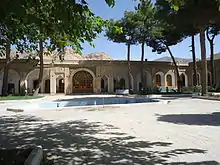Khorshidi dynasty
The Khorshidi dynasty (Lurish: Atabakan Luristan or Xoršidian) (Persian: لر کوچک, Lor-e kūchek) was a dynasty that ruled Little Lorestan between 1184 and 1597 [1][2] from Khorramabad.[3] The dynasty stemmed from the Jangardi tribe (Jangrūʾī or Jangardī).[3]
The rulers of Khorshidi dynasty were called Atabegs, with the word Atabeg resulting from the combination of the Turkish "ata" meaning "father", and "beg"/"bek"/"bak" meaning "great"/"big".[4] After the death of Hessameddin, Shuja' al-din Khurshid became the independent ruler of the entirety of Little Luristan. After Shuja' al-din Khurshid, a dynasty of his successors ruled Little Luristan. These Lurs formed the local dynasty of Atabakan-e-Luristan (1184-1597), during the Seljuk era, with the last governor of that dynasty, Shahverdi Khan, being executed by Shah Abbas the Great, thereby terminating the Khorshidi dynasty.[5] Shah Abbas then assigned Hossein Beyg (also known as Hossein Khan) of the Silvizi clan, the nephew of Shahverdi Khan, and grandson of Jahangir Atabeg, to rule over Little Lorestan, thus replacing the Khorshidi dynasty with a Lorish dynasty known as the Vāli/Wāli dynasty in 1597.[5][6]
List of Khorshidi rulers
- Shuja' al-din Khurshid bin Abubakr bin Muhammad bin Khurshid
- Saif al-Din Rustam bin Nur al-din
- Sharaf al-Din Abubakr
- Izz al-Din Garshasp
- Hisam al-Din Khalil bin Badr bin Shuja
- Badr al-Din Masud
- Taj al-Din bin Hisam al-Din Khalil
- Falak al-Din Hasan
- Jamal al-Din Khidr bin taj al-Din
- Hisam al-Din Omar bin Shams al-Din Darnaki bin Sharaf al-Din bin Tahamtan bin Badr bin Shuja
- Shams al-Din Mahmud bin bin Nur al-Din bin Izz al-Din Garshasp
- Izz al-Din Muhammad bin Izz al-Din
- Dawlat Khatun
- Izz al-Din Husain
- Shuja al-Din Mahmud
- Malik Izz al-Din bin Shuja al-Din
- Sidi Ahmad
- Shah Husain Abbasi
- Shah Rustam
- Oghur
- Jahangir
- Rustam Khan
- Shahverdi Khan[5]
Vāli Dynasty of Posht-e-Kuh
The Vāli Dynasty was the successor to the Khorshidi Dynasty and lasted until the Shah of Iran Reza Shah removed the last Vali, Gholam Reza Khan, from power after deciding to take over the territory of what was then called Posht-e-kuh (in what is today's Ilam Province) by sending brigadier general Koupal to capture Posht-e-kuh. With general Koupal's capture of

Ghaleh Vāli (Wāli/Vāli's Castle), the period of the Vāli dynasty was over after 744 years [5] putting an end to the longest ruling local dynasty in the history of Iran.[6]
See also
- List of Sunni Muslim dynasties
- Vāli Dynasty of Posht-e-Kuh
Sources
- The new Encyclopædia Britannica, Vol. VI, Encyclopædia Britannica, 1974, p. 331.
- Amanolahi, Sekandar (2002). "Reza Shah and the Lurs: The Impact of the Modern State on Luristan". Iran & the Caucasus. 6 (1/2): 193–218. doi:10.1163/157338402X00124. JSTOR 4030721.
- B. Spuller, "Atābekān-e Lorestān" in Encyclopædia Iranica.
- "The Lurs (lors) and Luristan". 2003. Archived from the original on May 3, 2005. Retrieved December 11, 2019.
- Saeidi, Golnaz (December 25, 2012). "Challenges of last governor (Vali) of Poshtkouh (Eilam) in Confronting Reza Khan". Life Science Journal. 9 (4, Part 33): 4944–4948. ISSN 1097-8135.
- Amanolahi, Sekandar (2002). "Reza Shah and the Lurs: The Impact of the Modern State on Luristan". Iran & the Caucasus. 6 (1/2): 193–218. doi:10.1163/157338402X00124. JSTOR 4030721.